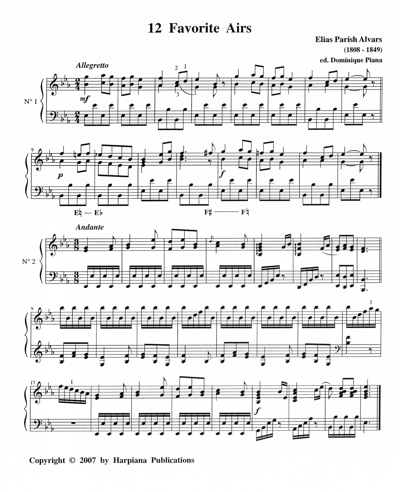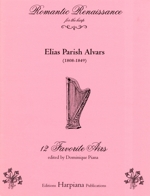| Editions
Harpiana Publications: Romantic Renaissance for the harp
|
| Editions Harpiana Publications - Index of Works |
| Elias Parish Alvars - Index of Works |

The 12 Favorite Airs (or Arias) arranged by Elias Parish Alvars were published (by Ricordi of Milan) in 1843 and present an interesting — and rare — example of his pedagogic mindset. The tunes he used must have been so well known that he didn’t need to identify them. Presented in progressive order, they deliver attractive learning tools, technically and stylistically, and countless pleasures to the ear and the heart.
Steeped in the bel canto culture of his
time, Parish Alvars had already composed several Fantasias, Divertissements
or Souvenirs on famous operas by Bellini, Donizetti and Rossini, with
more to follow by Donizetti, Mercadante and Verdi.
His Grand Fantasia on Rossini’s Moïse, published
just before the Airs, represented a great milestone in his development
as a composer and was recognized as an equal to pianist Sigismond Thalberg’s
famous composition on the same subject.
How did such a powerful interpreter, the “sorcerer” who “magnetized” Berlioz with his technical feats, adapt his formidable skills to the smaller format required for beginning and intermediate levels? He reduced the texture of these miniatures to the basics, at first using bare bone thirds, sixths and octaves (as in Nos. 1-2-4). without ever sacrificing the irrepressible character of the melodies. As the difficulty level increases, the accompaniment moves from predictable “Alberti bass” patterns to more complex running figures demanding the performer’s constant vigilance.
In a later edition published by Ashdown and Parry (Hanover Square. London), Nos. 2 and 4 are attributed to Bochsa, whereas No. 3 is ascribed to Meyerbeer as Nel silenzio (fra l’orror), a chorus from the opera Il Crociato in Egitto (1824) that is known to have been also arranged for piano by Parish Alvars’ contemporaries Thalberg and Henri Herz.
No. 7 offers an attractive reading of Nel cor più non mi sento, an aria from Paisiello’s 1788 opera L’amor contrastato ossia la Molinara, which became so well-loved in Germany that it was turned into an honorary folksong to the lyrics Michfliehen alle Freuden (All joys escape me), and was used by Beethoven himself as a theme for his Six La Molinara Variations in G in 1795.
No. 10 features the aria In mia mano elfin tu sei from Bellini’s Norma (Act II, scene X, rehearsal number 45), premiered in 1831. It’s a perfect example of a Bellini melody requiring the most delicate balance between beautiful singing and dramatic tension. Parish Alvars introduces the whole theme of the ultimate confrontation between Norma and her lover Pollione, ending with a dramatic fermata on the dominant... At which point he writes out a cadenza, which leads us straight back to the tune, this time presented at the upper octave, and embellished as if improvising on the spot. Thus the harp lesson mutates into a study in composition!
In regards to grace notes and turns, they must be thought of very freely. The typesetting of the turns in No.12 follows the original edition closely. Should they be measured or not? It is recommended to start with the easiest and slowest way of executing them and to experiment with different ways of spreading them out, since we are imitating singers who are declaiming their phrases with the most artful emotion or bravura.
Françoise Bourret from Quebec has typeset this collection in Finale.
Dominique Piana, Editor
| Title: | 12 Favorite Airs |
| Composer: | Elias Parish Alvars |
| Arranger: | Edited Dominique Piana |
| Instrumentation: | Harp |
| Level: | Intermediate |
| Format: | Stapled - score |
| Size: | 11" x 8.5" (US Letter) |
| ISMN: | Not issued |
| Our Ref: | DP044 |
| Publisher: | Editions Harpiana Publications |
| Series: | Romantic Renaissance |
| Edition/Year: | 2007 |
| Origin: | USA |
